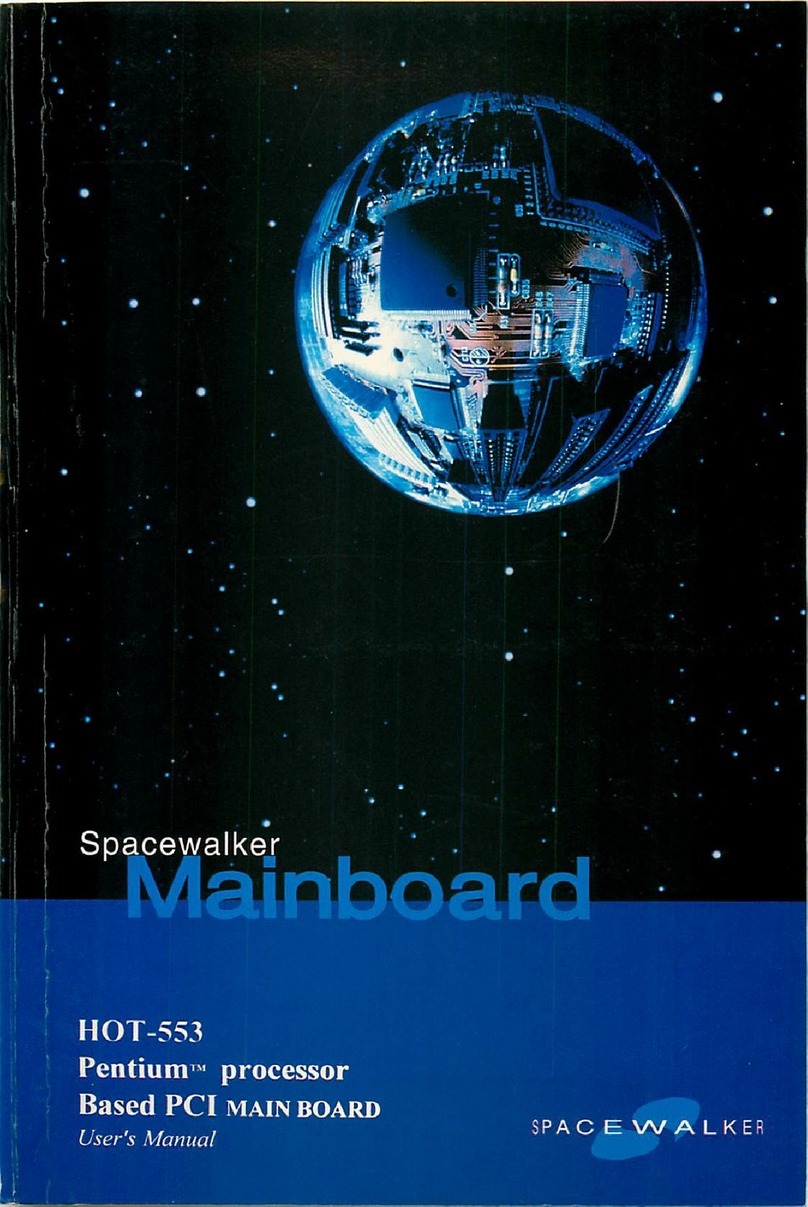spacewalker HOT-671 User manual

HOT-671
Pentium™IIprocessor
Based AGPMAINBOARD
User's Manual

2
FCC Notice:
This equipment has been tested and found to comply with the limits for a Class B digital device, pursuant to Part 15 of FCC
Rules. These limits are designed to provide reasonable protection against harmful interference in a residential installation.
This equipment generates, uses and can radiate radio frequency energy. If not installed and used properly, in strict accor-
dance with the manufacturer’s instructions, may cause harmful interference to radio communications. However, there is no
guarantee that interference will not occur in a particular installation. If this equipment does cause interference to radio or
television reception, which can be determined by turning the equipment off and on, the user is encouraged to try to correct
the interference by one or more of the following measures :
Reorient or relocate the receiving antenna.
Increase the separation between the equipment and receiver.
Connect the equipment into an outlet on a circuit different from that to which the receiver is connected.
Consult the dealer or an experienced radio/television technician for help and for additional suggestions.
The user may find the following booklet prepared by the Federal Communications Commission helpful “How to Identify
and Resolve Radio-TV Interference Problems.” This booklet is available from the U.S. Government Printing Office.
Washington, DC 20402, Stock 004-000-00345-4
FCCWarning
The user is cautioned that changes or modifications not expressly approved by the manufacturer could void the user’s
authority to operate this equipment.
Note: InorderforaninstallationofthisproducttomaintaincompliancewiththelimitsforaClassBdevice,shielded
cablesandpowercordmustbeused.
CE Notice:
Following standards were applied to this product, in order to achieve compliance with the electromagnetic
compatibility :
- Immunity in accordance with EN 50082-1: 1992
- Emissions in accordance with EN 55022: 1987 Class B.
NOTICE
Copyright 1998.
All Right Reserved
Manual Ver 1.0
All information, documentation, and specifications contained in this manual are subject to change without prior
notification by the manufacturer.
The author assumes no responsibility for any errors or omissions which may appear in this document nor does
it make a commitment to update the information contained herein.
TRADEMARKS
Intel is a registered trademark of Intel Corporation
PentiumII Processor is a registered trademark of Intel Corporation
PC/AT is a registered trademark of International Business Machine Corporation.
PS/2 is a registered trademark of IBM Corporation.
All other brand and product names referred to in this manual are trademarks or registered trademarks of their
respective holders.

3
TABLEOFCONTENTS
T
T
PREFACE ...................................................................................................................4
CHAPTER 1 INTRODUCTION ...........................................................................................5
Specification ....................................................................................................................................... 5
Accessories of HOT-671 .................................................................................................................... 7
CHAPTER 2HARDWARE CONFIGURATION........................................................................8
ThePentiumII &Celeron Processor ................................................................................................. 8
Whatdoesthe RM(RetentionMechanism) consistof ..................................................................... 9
InstalltheRetention MechanismandHeat SinkSupport ...............................................................10
InstallPentiumIIProcessor ............................................................................................................. 12
Celeron Processor S.E.P.P only RM Assembly Procedure .............................................................13
WhatdoesCeleron Processor RMconsistof .................................................................................. 14
Installthe CeleronProcessorRM. ................................................................................................... 14
InstallCeleronProcessor.................................................................................................................. 15
Jumpers ............................................................................................................................................. 16
CPUClockSpeed Selection -JP2and JP6......................................................................................16
ClearCMOS- JP11 .......................................................................................................................... 18
FlashEEPROMVpp - JP8 ............................................................................................................... 18
Keyboard&PS/2 Mousepower-onsetting(option)........................................................................ 19
Connectors ........................................................................................................................................ 19
CHAPTER 3MEMORY CONFIGURATION .........................................................................22
CHAPTER 4 FLASH UTILITY ........................................................................................23
CHAPTER 5 AWARD BIOS SETUP ..............................................................................25
The Main Menu ................................................................................................................................ 26
StandardCMOSSetup...................................................................................................................... 28
BIOS Features Setup......................................................................................................................... 30
ChipsetFeatures Setup ..................................................................................................................... 33
PowerManagementSetup ................................................................................................................ 36
PCIConfigurationSetup .................................................................................................................. 38
IntegratedPeripherals ....................................................................................................................... 40
PasswordSetting............................................................................................................................... 43
CHAPTER 6 ONBOARD SOUND CHIP SETTING .............................................................44
Introduction....................................................................................................................................... 44
Features ............................................................................................................................................. 44
SystemRequirements ....................................................................................................................... 45
ConnectingAudioDevices to 671BackPanel................................................................................ 46
Windows 95 Software Installation ................................................................................................... 47
Windows3.X/DOSSoftwareInstallation........................................................................................ 49
WindowsNT 3.51/4.0SoftwareInstallation ...................................................................................50
OS/2Warp 3.0/Merlin4.0 SoftwareInstallation ............................................................................ 51
InstallingandViewing HOT-671Utilitieson CD ..........................................................................52

4
PREFACE
P
P
HOT-671isa highlyintegratedIBM PC/ATcompatiblesystem board designedto meet
theindustry'smostdemandingdesktop applications.
Basedonthe Intel 82440EXAGPsetchipset, theIntelPentiumTMII processorwith
MMXtechnologyfeatured, and256KBor 512KB Level2 high-performance pipelined
burstsecondary168-pin DIMM socketandsupports up to256MBof EDO RAMand
SDRAM.
HOT-671isequipped with anAcceleratedGraphics Port (A.G.P.),ahigh-performance
interconnectforgraphic-intensiveapplication,such as3D applications.TheA.G.P. is
independentofthe PCI busandis designedtoexclusively use withgraphical-display
devices.TheHOT-671 supports3.3V A.G.P.deviceswith datatransferrates upto133
MHz,allowingdata throughputof500 MB/sec.
TheIntel's82440EX AGPset chipsetprovides an integratedBusMastering IDEcontrol-
lerwithtwo highperformance IDEinterfaceswhich allowsupto fourIDE devices
connectionandup to 33MB/secof datatransferrates.
Theon-board I/Ocontroller providesstandardPCI/Ofunctions:
floppydriveinterface, two FIFOserialports, an InDAdeviceport and aSPP/EPP/ECP
capable parallel port.
HOT-671isbuilt withthreePCI local busslots providing ahighbandwidth datapathfor
data-movementintensivefunctions such asgraphics,and with oneISAslot.
HOT-671provides thefoundation forcost effective,high performanceand highly
expandableplatforms,whichdeliversthelatestin theIntel PentiumTM IIprocessorand
newadvancedchipsettechnology.

5
SPECFICATION
1
1
TheHOT-671Mainboard iscarefully designedforthe demandingPC userwhowants highperfor-
manceandmany intelligent featuresin a compactpackage:
IntelChipset:
FeaturesIntel's440EX AGPset withI/Osubsystems.
CPUSupport:
Intel Pentium®IIandCeleron processor233 ~333MHz.
VersatileMemorySupports:
Equipped with two DIMM sockets support 168-pin3.3V SDRAM andEDODRAM memory
modules,totalmemory size upto256MB.
Configurablesupportfor ECC(Error CheckingandCorrecting)
PCIandISAExpansionSlots:
Providesthree32-bit PCIslotsand one16-bitISA slot.
AGPSlot:
SupportsAccelerated GraphicsPortcardsforhighperformance,component levelinterconnect
targeted at 3D graphical display applications.
OnboardI/O:
ProvidesoneFloppyport;oneoptionalPS/2 mouseconnector; two high-speedUART compatible
serial ports and one parallel port with ECP and EPP capabilities. Serial Port 2 can also be directed
fromCOM2to the Infrared Moduleforwireless connections.
OnboardPCIBusMasterIDEController:
Two UltraDMA/33 BusMaster IDE Portssupportsfour IDEdevicesup to 33MB/sec IDE trans-
fersandsupports Enhanced PIOModes 3 and4and BusMasterIDE DMA Mode2 devices.
Onboard20-pinATXPower Supply:
ProvidesATXpower connectoronboardsupports soft-on/offfunction.
SystemBIOS:
ProvideslicensedAwardV4.51PGBIOSonFlashEEPROM.
SupportsGreenPC, DMIand BundledwithNCR SCSIBIOS.
ACPI:
Support ACPI(AdvancedConfigurationandPower Interface) function. ACPI provide more
EnergySavingFeatures forthe futureoperatingsystemsupportingOS DirectPowerManagement
(OSPM)functionality.
Table of contents
Other spacewalker Motherboard manuals



















